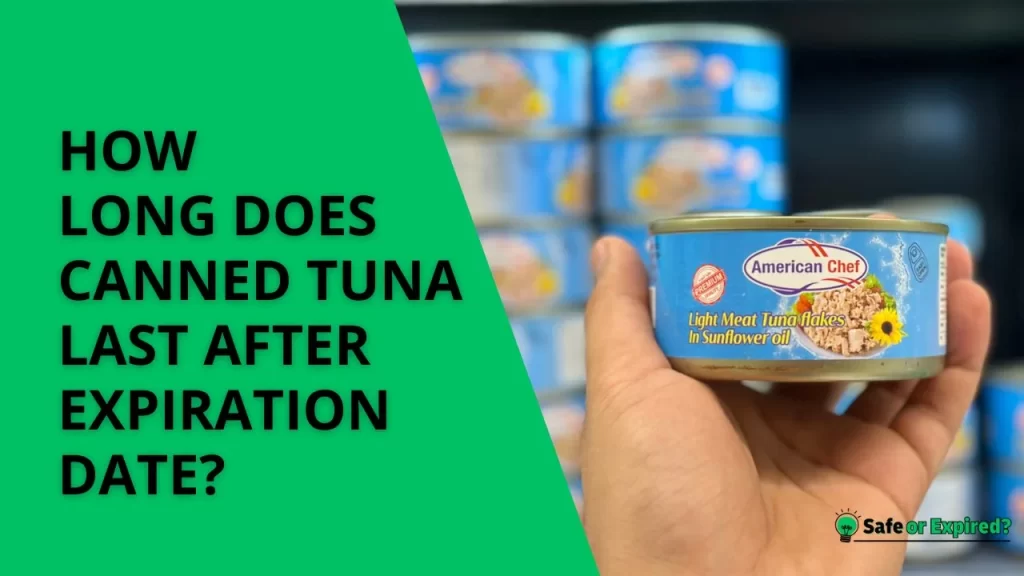“How long does canned tuna last after expiration date?” question often arises as we rummage through our pantry looking for a quick meal. The answer is up to two years, but there’s a lot more info you should know before you make any decision.
In this article, you will learn the shelf life of canned tuna, how to tell when it goes bad, and what will happen if you eat the expired one. Let’s begin.
How Long Does Canned Tuna Last After Expiration Date? (End-Date)
Canned tuna can last 1-2 years past its expiration date if you store it in a dry place. The quality might decline, but it will remain safe to consume if the can is undamaged and not bulging. Always check for any off smells or textures before eating.
To check the expiration date, take a good look at the can.
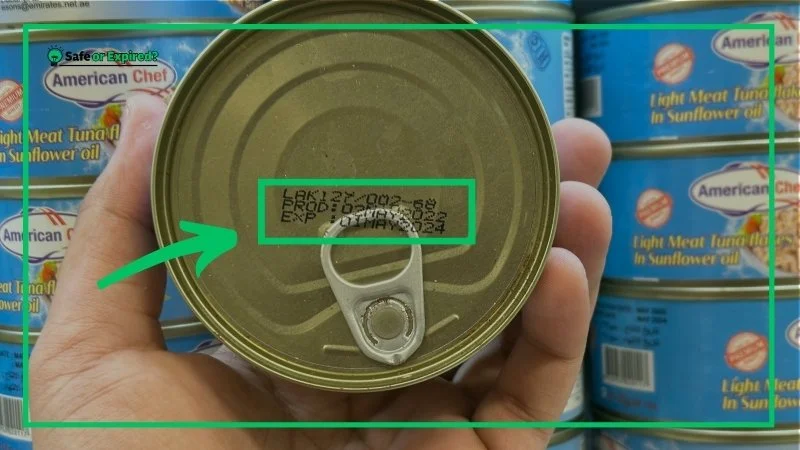
People have another question, “How long does canned tuna last after expiration date in water?” well, canned tuna packed in water can last beyond its expiration date (similar to any canned tuna), extending up to 2 years past the printed date (when stored correctly). So, check the expiry date, and then you will know for how long you can eat it.
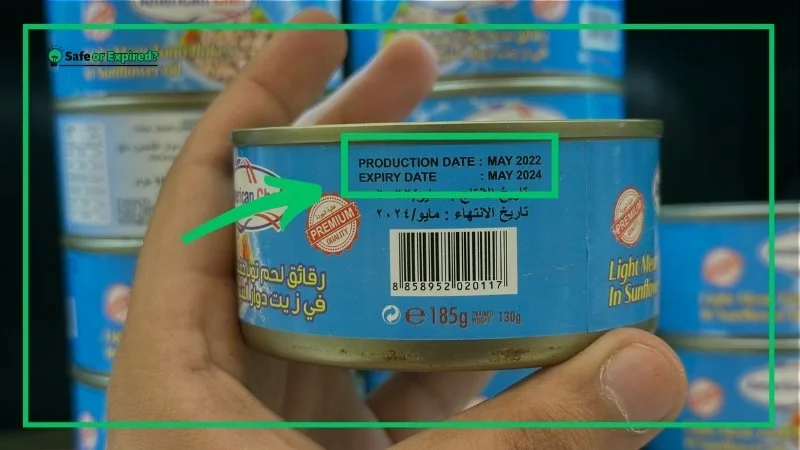
Canned Tuna Expiry: Opened vs Unopened
People often ask, “How long does canned tuna last unopened?” Unopened canned tuna retains its best quality for 2-5 years when stored in a cool, dark place. Although it remains safe beyond this period, its flavor, texture, and nutritional value might gradually deteriorate. Always inspect the can’s integrity before use, regardless of its age.
You might now be wondering, “How long does canned tuna last in the fridge once opened?” Well, for 3-4 days. The cold environment slows bacterial growth, preserving its freshness. Consuming it within this timeframe ensures its taste and safety. That’s all about the canned tuna shelf life after opening. Now, let’s discuss refrigeration.
Canned Tuna Expiry: Refrigerated vs Unrefrigerated
Questions like “How long does canned tuna last out of the fridge?” are pretty common. Once opened and unrefrigerated, canned tuna should be consumed within 2 hours. Beyond this, bacteria can rapidly grow, especially at room temperatures between 40°F (4°C) and 140°F (60°C), making it unsafe to eat. It may last slightly longer in cooler environments but should still be consumed promptly.
You may be wondering, “Can canned tuna go bad in heat?” Canned tuna can go bad in excessive heat, especially if opened. High temperatures accelerate bacterial growth and spoilage. Unopened cans are more resilient but vulnerable to quality degradation in hot conditions. Avoid storing tuna in direct sunlight or hot areas to maintain its safety and quality.
Here’s a complete table detailing the storage and expiry guidelines for canned tuna:
| Storage Condition | Opened Canned Tuna | Unopened Canned Tuna |
| Counter | Not recommended after opening | 2-5 years past “best by” date, if stored in a cool, dry place |
| Fridge | 3-4 days in a sealed container | Not applicable (store in pantry) |
| Freezer | 1-2 months in a freezer-safe container | Not recommended due to potential texture changes and degradation of quality |
How to Tell Canned Tuna Has Gone Bad? (5 Signs)
To determine if canned tuna has gone bad, inspect the can for bulging, leaks, or rust, indicating spoilage. Then, assess the tuna’s appearance for any unusual discoloration or mold. A foul or significantly fishy smell is a clear sign of spoilage.
Check the Can’s Condition
Before you even open the can, give it a good look. If you notice any dents, rust, or bulging, it’s a red flag. These signs might indicate that the tuna inside has gone bad due to bacterial growth or a compromised seal. Here’s what a good tuna can look like:
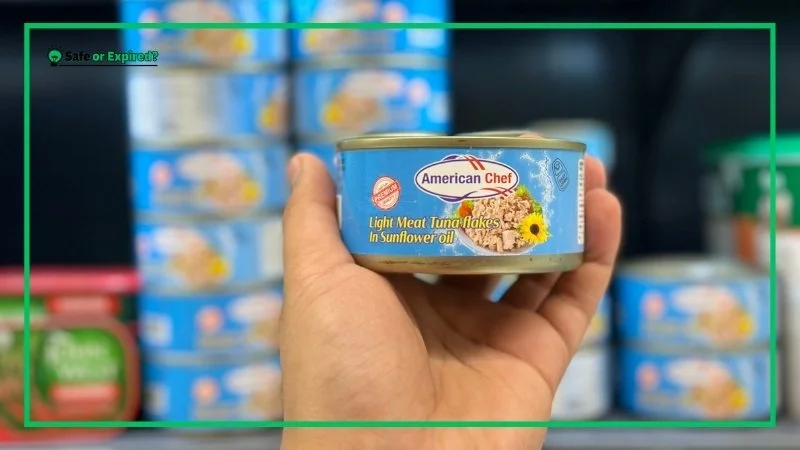
Remember, a can in perfect shape doesn’t guarantee the contents are safe to eat, but a damaged can is a cause for concern.
Listen for a Hiss
When you open the can, pay attention to the sound it makes. A slight hiss is normal as you break the seal, but a pronounced or delayed hissing could mean gas has built up inside — a clear sign of spoilage.
Inspect the Tuna’s Appearance
Once you’ve opened the can, take a good look at the tuna. Fresh canned tuna should have a relatively consistent color, depending on whether it’s packed in water or oil. If you see any discoloration, mold, or anything that doesn’t look right, it’s best to err on caution and throw it away.
Smell Test
Your nose knows best! Fresh canned tuna might have a mild oceanic aroma, but it shouldn’t smell foul or overly fishy. If you’re greeted by an unpleasant or strong odor when you open the can, it’s a sign that the tuna is no longer good to eat.
Texture Tells a Tale
Finally, check the texture. If the tuna looks overly mushy or has an unusual texture, it’s better not to risk it. Canned tuna should maintain some firmness and not turn into a complete mush.
What Happens If You Eat Expired Canned Tuna? (Everything to Know)
Eating expired canned tuna can lead to foodborne illnesses. Symptoms might include stomach cramps, nausea, vomiting, diarrhea, and, in severe cases, dehydration and fever. The severity depends on the level of spoilage and individual susceptibility. Always prioritize safety and inspect canned goods before consumption to avoid health risks.
Risk of Foodborne Illness
Consuming expired canned tuna that has spoiled can lead to foodborne illnesses. In these diseases, you will have symptoms like nausea, vomiting, diarrhea, and abdominal pain.
Botulism Concern
There’s a risk of botulism from improperly stored or damaged canned foods, including tuna. Don’t take Botulism lightly, as it can lead to paralysis and requires immediate medical attention.
Minor Symptoms in Some Cases
If the tuna is slightly past its expiration but still in good condition, you might not experience any symptoms. The risk increases significantly with visible spoilage and poor storage conditions.
To avoid health risks, always pay close attention to canned tuna’s storage instructions and expiration dates. It’s safer to discard the can than risk illness when in doubt.
How to Maximize the Shelf Life of Canned Tuna? (5 Tips)
You can maximize the shelf life of canned tuna by storing it in a cool, dry spot. Once opened, transfer the tuna to an airtight container and refrigerate, consuming within 3-4 days. Regularly check your pantry to ensure cans are undamaged, and use older cans first to prevent spoilage.
Store It in the Right Place
The first step to ensuring your canned tuna lasts is storing it correctly. A dry cupboard or pantry is the good spot. Remember that extreme temperatures can affect the can and its contents, so a stable environment is key. For example, placing cans in a cupboard above your stove might seem convenient, but the fluctuating temperatures could degrade the tuna’s quality faster.
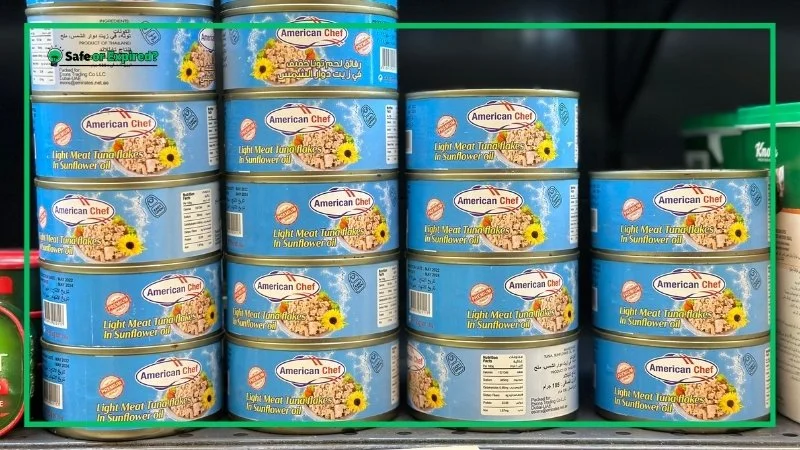
Mind the Date
While canned foods are known for their long shelf life, paying attention to the “best by” dates is still important.
Here’s a tip: To manage your stock efficiently, organize your cans in order of their expiration dates, using the oldest ones first. This practice, known as the “first-in, first-out” method, can prevent you from accidentally keeping cans past their optimal quality period.
Keep It Cool After Opening
Once you’ve opened a can of tuna, any leftovers need to be handled differently. Transfer the tuna to a clean container and refrigerate it immediately. This will definitely slow down bacteria and keep the tuna fresh for 3-4 days. A tip to remember is to use a clear container so you can easily see what’s inside without having to open it, which helps maintain its freshness.
Use Your Senses
Finally, always trust your senses before using canned tuna – even if it hasn’t expired. Before you prepare a meal, check the can for any signs of damage, such as dents, rust, or swelling, which could indicate contamination. Upon opening, look for any unusual appearance or odors. Fresh canned tuna should have a clean, sea-fresh scent, not an overpowering fishy smell. If something seems off, it’s better to err on the side of caution and discard the can.
Temperature Fluctuations Matter
Be mindful of how temperature changes affect canned goods. For instance, if you live in a particularly hot or humid climate, consider storing your canned tuna in a cooler part of your house. Even within the “safe” confines of your home, areas that experience significant temperature shifts can shorten the shelf life of canned foods.
By following these tips, you can maximize the shelf life of your canned tuna, ensuring it remains delicious and safe to eat for as long as possible. Always remember that the key to food safety is precaution and proper storage.
Just like canned tuna, evaporated milk is another pantry essential that many wonder about when it comes to expiration and safety. Given its use in cooking and baking, knowing the shelf life of canned evaporated milk can help you make the most of this versatile ingredient without compromising on quality or safety. If you’re curious about how long you can keep using evaporated milk after its ‘best by’ date, check out this guide, “Does Canned Evaporated Milk Expire? All About Its Shelf Life”.
Conclusion
Navigating the shelf life of canned tuna doesn’t have to be daunting. With the right knowledge and practices, you can confidently use your canned goods, reducing waste and ensuring food safety. Here are the key takeaways:
- Canned tuna can last 1-2 years past its expiration date when stored properly in a cool, dry place.
- Inspect cans before use for any signs of damage, such as bulging, rust, or leaks, to avoid potential health risks.
- Store opened tuna in the refrigerator in a tightly sealed container to extend its freshness for up to 4 days.
- Rely on your senses to check for spoilage, including off odors, discoloration, or an unusual texture.
- When in doubt, throw it out to ensure your safety, health, and your family.
Remember these points and enjoy your canned tuna at its best!

